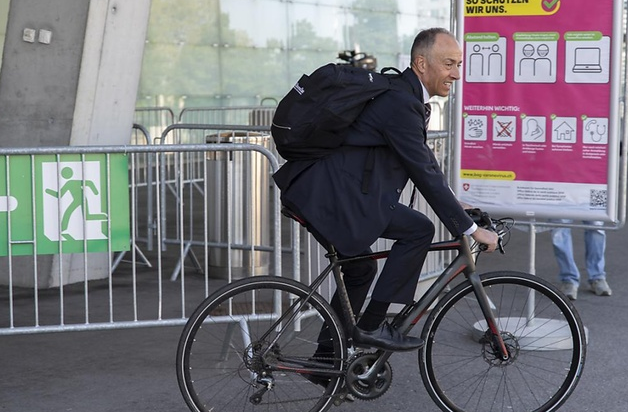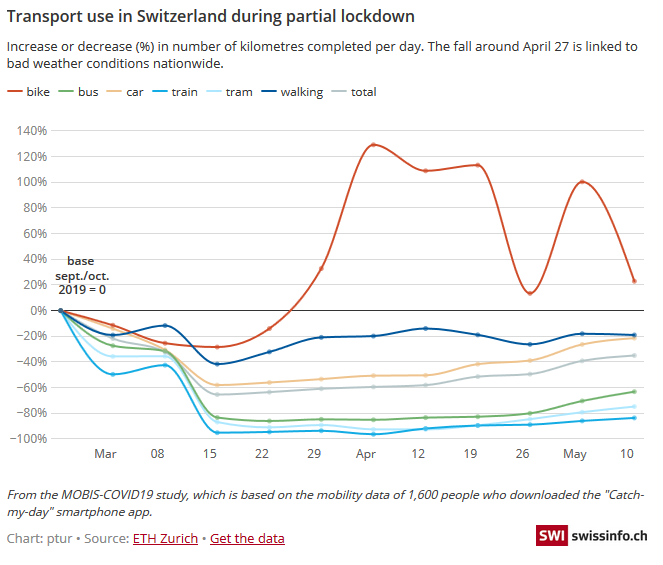|
While demand for public transport collapsed during Switzerland’s partial lockdown, bicycle usage soared across the country. But greater acceptance of cycling nationwide will depend on further political decisions and transport planning. Ernst Leuthold, the owner of a bike shop in Bern, can’t believe his eyes. “It’s amazing to see all these people who haven’t been on a bike for years and then suddenly feel the need to do so,” he declared. Daniel Schärer, director of 2roues Suisseexternal link, a trade association for two-wheel vehicles, concurs: “During the lockdown, bike shop repair workshops were extremely busy.” And it’s likely that the sales of bikes will take off in the coming months, he added. Most of these new clients probably discovered cycling for fun whilst at home. But “there are undoubtedly others who turned to bikes, particular electric bikes, to go to work”, he added. If bike usage is to continue to grow, it will most likely be people who combine cycling with other forms of transport as most of the population work far from their homes. For example, this could involve cycling to the station in the morning and taking a train to work and then doing the same on the way home. |
 Swiss parliamentarian Rocco Cattaneo, a former professional cyclist, arrives on his bike at the extraordinary session of parliament in Bern during the coronavirus crisis. (sda-ats) |
The bike is backJörg Beckmann, a transport sociologist and director of the Mobility Academyexternal link, is convinced that commuters could turn to other forms of transport. The sharp spike in e-bike sales during the lockdown is a possible sign of this. “It’s possible that some commuters will cycle to work to avoid public transport,” he said. Unlike other forms of transport, bike usage has increased sharply during the lockdown. An ETH Zurich Mobisexternal link study revealed that on some days during the lockdown, cyclists covered three times the number of kilometres compared with autumn 2019. But it is clear that further political decisions and transport planning are necessary to ensure this new mobility is properly integrated as society slowly returns to normal. |
Transport use in Switzerland during partial lockdown |
A long road ahead
During the recent surge, this month the government announced the creation of legal foundations to improve the quality and safety of cycle paths in Switzerland. This follows Swiss voters’ approval in 2018 of a proposal to enshrine cycling and cycling infrastructure in the country’s constitution.
In a statementexternal link, the government said cantons were responsible for building cycle paths and would be obliged to plan a safe network of interconnected routes.
Pro Vélo, the Swiss cycling association, was full of praise forexternal link the Swiss authorities. “They have understood the population’s clear wish to see an increase in cycling traffic and want to reply to this,” it declared.
However, it added: “There is still a long way to go before Switzerland catches up with other model countries like the Netherlands or Denmark,” said Pro Vélo President Matthias Aebischer.
The problem is that cycling is not a political priority in Switzerland, Patrick Rérat, professor at the University of Lausanne, recently told the Le Temps newspaper. While many other European cities quickly moved to create additional cycling paths during the pandemic – Rome (150 km), Brussels (40km), Berlin (22km) and Barcelona (21km) – there were few changes in Switzerland.
Yet there is a clear link between safe cycling infrastructure and increased usage, said Rérat.
“In Switzerland the cities with the best cycle paths are Basel and Bern. And that’s where there are the most cyclists,” he added.
Full story here Are you the author? Previous post See more for Next postTags: Business,newsletter
































